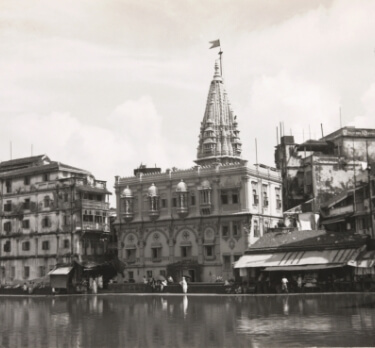GALLERY 01 | WATER AND BUILT HERITAGE
EXHIBIT 01/04
Water and the City: A Timeline




Potable water is critical to the development of cities, particularly those like Bombay which was historically a centre of maritime trade and a bustling financial capital. Till the mid-19th century, most of Bombay’s water needs were met by either private household wells, or public water tanks and fountains, several of which were constructed by notable philanthropists from all faiths.
However, water shortages were not unusual and the colonial administration experimented with several different measures to reduce the pressure on water systems. In 1858, the first plans for transporting water from Vihar Lake, a distance of 90 kilometres, were initiated.
Hydraulic engineering and notions of public hygiene, particularly in relation to the military, soon paved the way for the closure of several wells and tanks deemed unsanitary or malaria-infested. Piped water came to symbolise moral, social and scientific progress as Mumbai evolved, and today very few tanks, wells or public fountains remain in use.
This timeline explores the development of water systems and services in the city from the 1600s to the present, punctuated by key milestones of growth and disease which have defined the shape of potable water for residents.
कोणत्याही शहराच्या विकासासाठी पिण्यायोग्य पाणी ही एक अत्यावश्यक गरज असते. विशेषतः प्रमुख व्यावसायिक बंदर असलेल्या आणि देशाची आर्थिक राजधानी असलेल्या मुंबईसाठी तर नक्कीच. १९व्य शतकाच्या मध्यापर्यंत आपल्या शहराची पाण्याची गरज मुख्यत्वे खाजगी किंवा सार्वजनिक विहिरी, तसेच दानशूर व्यक्तींनी बांधलेले सार्वजनिक तलाव, प्याऊ, पाणपोया यांच्या मार्फत शमविली जात असे. असे असले, तरी, पाण्याची कमतरता भासणे काही नवीन नाही.
ब्रिटिश प्रशासनाने पाणी प्रश्न हाताळण्यासाठी अनेक योजना राबविण्याचा प्रयत्न केला. १८५८मध्ये सर्वप्रथम, विहार तलावापासून ९०किलोमीटर लांबीची जलवाहिनी जोडली गेली. हायड्रॉलिक इंजिनिअरिंग, सार्वजनिक स्वच्छता (विशेषतः लष्करी दृष्टिकोनातून) बऱ्याचशा विहिरींचा वापर बंद करण्यात आला, तसेच निरुपयोगी व मलेरिया डासांची पैदास होण्यास कारणीभूत होतात असा अपप्रचार तलावांच्या बाबतीत केला गेला.
मुंबईच्या नैतिक, सामाजिक आणि वैज्ञानिक प्रगतीचे द्योतक म्हणून जलवाहिन्यांकडे पाहिले जाऊ लागले. याच मुळे आज फारच कमी तलाव, विहिरी आणि सार्वजिनक पाणपोया वापरायोग्य राहिल्या आहेत.
१७व्या शतकापासून ते आजतागायत मुंबई शहराच्या पाणी पुरवठ्याची साधने आणि पद्धतींमधील स्थित्यंतरे, या सोबतच विकासाचे प्रमुख टप्पे आणि पिण्या योग्य पाण्याची व्याख्या अधोरेखित करणाऱ्या साथीचे आजार याचा आढावा या 'टाइमलाईन' प्रदर्शनातून घेतला गेला आहे.




